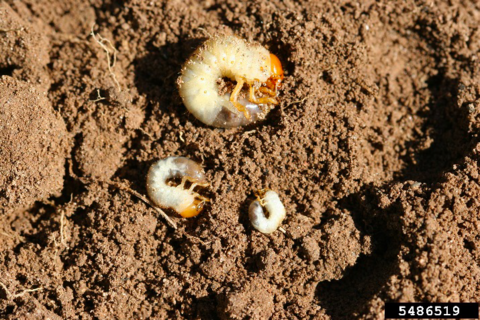University of Minnesota Extension, Stearns County News
August 19, 2020
Katie Drewitz, Extension Educator-Horticulture, Small Farms and Local Foods
University of Minnesota Extension
Stearns, Benton and Morrison counties
White Grub Control in Lawns
By Katie Drewitz, University of Minnesota Extension
ST. CLOUD, Minn. (8/19/2020) – If you are seeing unsightly brown patches in your lawn, you might be having a problem with white grubs. White grubs are soil-dwelling larvae of beetles. The adult beetles emerge in late June and lay eggs in the turf during July. The eggs hatch in 2 to 3 weeks and tiny white grub larvae begin to eat the grass roots. The grubs grow rapidly and are fully grown at by late August or September. Feeding by the grubs prunes the roots from the plants and causes the grass to wilt and fade. Extreme feeding by populations of 10 or more annual white grubs per square foot will cause the grass to die. White grubs move several inches deep in the soil to spend the winter. They move back near the surface in the spring time but cause little additional damage as they wait to pupate in June, emerge as adults and start the cycle over.
Damage from white grubs in lawns can show up any time after mid-August, though damage may not become obvious until September or even into October. Damage from white grubs is usually localized, and it is typical to have severe damage in irregular and isolated spots.
White grub damage may first appear as drought stress (gray-green discoloration and wilting in the hot sun). More severe damage causes the turf to die in large irregular patches that can be rolled back like a loose carpet. High populations of grubs may go unnoticed until discovery by raccoons or skunks. Raccoons, skunks and crows will turn over large patches of loose turf, eat the grubs and leave behind a torn-up mess. White grub infestations are highly variable from year to year and from place to place. Damage is spotty and impossible to predict.
Preventive insecticide treatments should be applied from late May to early August. The insecticide must be watered in with irrigation or rainfall to be effective (0.5-inch minimum). Applications after mid-August and in the spring time, when grubs are fully grown, are not effective. Insecticides available to homeowners for white grub prevention include Imidacloprid (Merit, etc.); Chlorantraniliprole (Grub-Ex); and Bacillus thuringiensis galleriae (grubGONE). In August - September apply a fast-acting, short-lived, curative insecticide to reduce the number of white grubs can be applies. Curative insecticides are not as good as preventive insecticides at reducing the number of grubs. Insecticide treatments after early October are not effective and are not recommended. Unfortunately, raccoons and skunks are much better at locating grub populations than we are and the first hint of a grub problem in your turf is likely to be that your lawn was "plowed" by varmints overnight. Insecticides for curative grub control include Trichlorfon (Dylox, Bayer Advanced 24-Hour Grub Control) and Carbaryl (Sevin, etc.). One-half inch of irrigation immediately after insecticide application is essential for good results and to promote recovery of damaged turf. If you choose to apply insecticides, read and carefully follow directions.
If you have questions or would like more information about white grubs or any other horticultural questions, please reach out to your local Extension Educator. Residents in Stearns, Benton and Morrison Counties can call 320-255-6169 extension 1 or email wins0115@umn.edu. You can sign up to receive informational and event email updates for the Stearns, Benton and Morrison County area.


